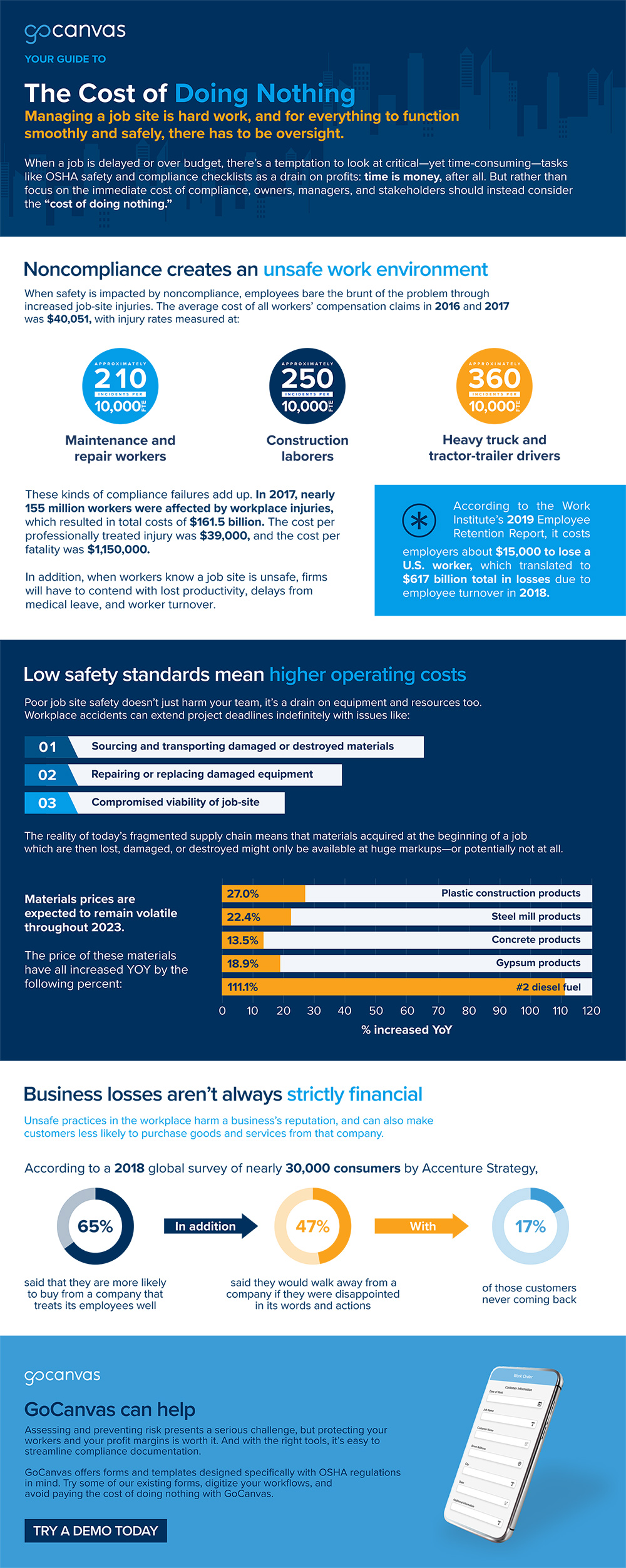The Cost of Doing Nothing

Check out even more resources
How Digital Work Orders Impact Your Key Business Outcomes
Is your company still using paper sheets to manage work orders? The drawbacks of using paper forms are often hidden, making it difficult to understand the true impact of paper forms on a business…
See How Centurion Got Amazing ROI from GoCanvas
Centurion is the largest heavy haulage provider in Australia. They deliver national supply chain solutions to the resources, energy, construction & retail sectors throughout Western Australia, Queensland & the Northern Territory…
5 Tips to Improve How Your Business Collects Data
Companies rely on collecting data in order to operate. In a fast-changing world, companies that focus on streamlining and improving their data collection processes will be able to do more. The good news is that it’s become easier than ever for businesses of all…
Connect with an Expert Today.
We’ll help you put together the right solution for your needs.
Text Version
The Cost of Doing Nothing
Managing a job site is hard work, and for everything to function smoothly and safely, there has to be oversight.
When a job is delayed or over budget, there’s a temptation to look at critical-yet time-consuming tasks like OSHA safety and compliance checklists as a drain on profits: time is money, after all. But rather than focus on the immediate cost of compliance, owners, managers, and stakeholders should instead consider the “cost of doing nothing.”
Noncompliance creates an unsafe work environment
When safety is impacted by noncompliance, employees bare the brunt of the problem through increased job-site injuries. The average cost of all workers’ compensation claims in 2016 and 2017 was $40,051, with injury rates measured at:
APPROXIMATELY 210 INCIDENTS PER 10,000 Maintenance and repair workers
APPROXIMATELY 250 INCIDENTS PER 10,000 Construction laborers
APPROXIMATELY 360 INCIDENTS PER 10,000 Heavy truck and tractor-trailer drivers
These kinds of compliance failures add up. In 2017, nearly 155 million workers were affected by workplace injuries, which resulted in total costs of $161.5 billion. The cost per professionally treated injury was $39,000, and the cost per fatality was $1,150,000.
In addition, when workers know a job site is unsafe, firms will have to contend with lost productivity, delays from medical leave, and worker turnover.
According to the Work Institute’s 2019 Employee Retention Report, it costs employers about $15,000 to lose a U.S. worker, which translated to $617 billion total in losses due to employee turnover in 2018.
Low safety standards mean higher operating costs
Poor job site safety doesn’t just harm your team, it’s a drain on equipment and resources too. Workplace accidents can extend project deadlines indefinitely with issues like:
1 Sourcing and transporting damaged or destroyed materials
2 Repairing or replacing damaged equipment
3 Compromised viability of job-site
The reality of today’s fragmented supply chain means that materials acquired at the beginning of a job which are then lost, damaged, or destroyed might only be available at huge markups—or potentially not at all.
Materials prices are expected to remain volatile throughout 2023.
The price of these materials have all increased YOY by the
following percent:
27.0% Plastic construction products
22.4% Steel mill products
13.5% Concrete products
18.9% Gypsum products
111.1% #2 diesel fuel
Business losses aren’t always strictly financial
Unsafe practices in the workplace harm a business’s reputation, and can also make customers less likely to purchase goods and services from that company.
According to a 2018 global survey of nearly 30,000 consumers by Accenture Strategy,
65% said that they are more likely to buy from a company that treats its employees well
47% said they would walk away from a company if they were disappointed in its words and actions
17% of those customers never coming back
GoCanvas can help
Assessing and preventing risk presents a serious challenge, but protecting your workers and your profit margins is worth it. And with the right tools, it’s easy to streamline compliance documentation.
GoCanvas offers forms and templates designed specifically with OSHA regulations in mind. Try some of our existing forms, digitize your workflows, and avoid paying the cost of doing nothing with GoCanvas.